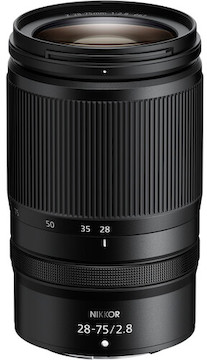The Nikon Z 28-75mm f/2.8 is a versatile fast-aperture wide-to-portrait zoom for Nikon Z-Mount cameras. Key features include:
Only for Nikon Z-mount cameras
Great for landscape, portrait, and street photography
Advanced optical design; fast constant aperture
Stepping autofocus system with full-time manual focus
Nikon Z System. The Nikon Z 28-75mm f/2.8 was designed specifically for cameras in Nikon’s Z-mount system. Z-mount lenses only work with Z-mount cameras, and Z-mount cameras are only compatible with Z-mount lenses.
Fast-Aperture Wide-to-Portrait Zoom. The 28-75 f/2.8 provides a wide-to-portrait focal range, making it perfect for landscape, portrait, documentary, and street photographers. The relatively fast f/2.8 aperture offers some shallow depth of field, while allowing you to keep shooting even when the lights get dim. Using a DX-mount camera? You’ll get a 18-50mm equivalent focal-length range.
Stepping Autofocus System. This lens’s autofocus system gives you fast, accurate performance throughout the zoom range. This system’s stepping motor provides smooth, nearly silent performance that’s particularly suited to video applications. You also get full-time manual focusing for precision adjustments, while the internal-focusing design means that the lens maintains its length during focusing.
Advanced Optics. The 28-75mm’s twelve-group/fifteen-element optical system includes three aspherical elements, one extra-low dispersion element, and one super extra-low dispersion element. These work together to create sharpness, clarity, and accurate color rendering throughout the zoom range. A rounded nine-blade diaphragm helps produce pleasing bokeh when you’re using shallow depth-of-field and selective-focus techniques.
High-Quality Build. This lens’s durable, dust- and moisture-resistant construction means you can use it in adverse conditions without worry. The exposed elements have an antifouling coating to protect them from debris and smearing. A programmable control ring lets you adjust manual focus, aperture, or exposure compensation.




